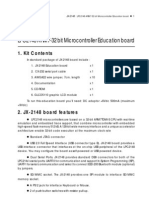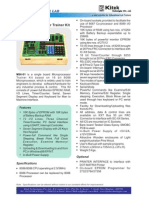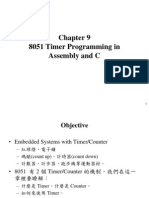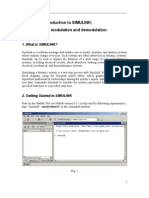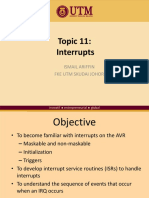STM32 Tutorial 04 - I2C Module (Pca9685) Using HAL (And FreeRTOS)
Uploaded by
Quocdt NgocSTM32 Tutorial 04 - I2C Module (Pca9685) Using HAL (And FreeRTOS)
Uploaded by
Quocdt NgocSTM32 Tutorial NUCLEO F103RB GPIO Pins
I2C communication on STM32 Microcontrollers using HAL
UART
You can use the STM32CubeMX tool to create the necessary config. files to enable the I2C-Drivers.
The HAL library provides the necessary functions to communicate to with the I2C protocol.
I’m going to show you how to output I2C with the HAL library using a PCA-9685 16-channel 12-Bit LED
driver.
Note ! For this tutorial, it is advised to have at least a basic
understanding of the I2C protocol and the necessary components.
This tutorial uses the following equipment:
- NUCLEO-F072RB Board
- Keil uVision 5 with the necessary packages for Nucleo boards installed
- STLink USB Driver
- STM32CubeMX
- PCA 9865 chip or module
- (Oscilloscope to analyse the signal)
STM32CubeMX
Generating the config. files from STM32CubeMX.
1. Open STM32CubeMX and open a new project.
2. Select the Nucleo-F072RB from the Borards tab
3. Enable FreeRTOS
4. Set the RCC (HSE & LSE) to Crystal/Ceramic Resonator
5. Enable the USART2 port in Asynchronous mode
6. Enable the I2C1 module and remap the SDA/SCL pins to PB8/PB9
7. Go to Project > Generate code
8. Enter a project name and select MDK-ARM V5
9. Generate the code and open the project in Keil uVision
V1.0.1 – created on 20.05.2016 simon burkhardt page 1 /6
STM32 Tutorial NUCLEO F103RB GPIO Pins
Now let’s see what the code generator did
174 /* I2C1 init function */
175 void MX_I2C1_Init(void)
176 {
177
178 hi2c1.Instance = I2C1;
179 hi2c1.Init.Timing = 0x2000090E;
180 hi2c1.Init.OwnAddress1 = 0;
181 hi2c1.Init.AddressingMode = I2C_ADDRESSINGMODE_7BIT;
182 hi2c1.Init.DualAddressMode = I2C_DUALADDRESS_DISABLED;
183 hi2c1.Init.OwnAddress2 = 0;
184 hi2c1.Init.OwnAddress2Masks = I2C_OA2_NOMASK;
185 hi2c1.Init.GeneralCallMode = I2C_GENERALCALL_DISABLED;
186 hi2c1.Init.NoStretchMode = I2C_NOSTRETCH_DISABLED;
187 HAL_I2C_Init(&hi2c1);
188
189 /**Configure Analogue filter
190 */
191 HAL_I2CEx_AnalogFilter_Config(&hi2c1, I2C_ANALOGFILTER_ENABLED);
192
193 }
194
Nothing special here. Just note, that you have the option to change the addressing mode to
I2C_ADDRESSING_MODE_10BIT.
I2C Basics
Note ! This info is essential when working with I2C protocol. Possible
sources of error are marked with red blocks.
The I2C always needs to be terminated with a pull-up resistor on each SDA and SCL. Typical values can
range from 4k7 to 22k.
error Bus not terminated. This is the case, when SDA and SCL are in a low
state (GND) instead of pulled high.
The I2C protocol works as follows:
The bus is activated with a start condition. (SCL pulled low after SDA was pulled low)
Followed by the slave address.
Slave address:
- Bits 7 – 4 are a unique address, each family of chips has a unique combination
- Bits 3 – 1 determines the id of a chip. They are usually set with pull-up / pull-down resistors
- Bit 0 determines if a read or a write access is being performed on the slave
V1.0.1 – created on 20.05.2016 simon burkhardt page 2 /6
STM32 Tutorial NUCLEO F103RB GPIO Pins
The address is followed by the first data byte.
The slave acknowledges the reception of the byte with an ACK bit.
After the first data byte and its acknowledgment, a series of any number of bytes can be transmitted.
error The slave does not ACK the reception. This case occurs, if the
address was incorrect. Check your datasheets to find the correct
address.
The end of transmission is then marked with the stop condition. (SDA is pulled high after SCL was
pulled high)
How to send data over I2C
Sending bytes of data using the function provided within the HAL library.
1 HAL_I2C_Master_Transmit(&hi2c1, 0x80, 0x0F, 1, 1);
The first argument is a pointer to the instance of an I2C module.
The second argument is the slave address. In this case, 0x80 is the default address of the pca 9685
family.
The third argument is the byte to be sent. 0x0f is easy to check on an oscilloscope.
The fourth argument is the size (in bytes) of the outputted data. In our case it is only 1 byte great.
The last argument is the timeout value. If sending only one byte, you should be good with a value of 1.
Note ! If more than one byte of data is being outputted, and the slave does
not acknowledge the first byte, the timeout comes in handy.
It prevents the function from unsuccessfully waiting for an
acknowledgement (infinite loop).
You can also enter a pointer to an 8bit value like this.
1 uint8_t outbuffer = 0xFF;
2
3 HAL_I2C_Master_Transmit(&hi2c1, 0x80, &outbuffer, 1, 1);
4
1 uint8_t outbuffer[3] = {0xFF, 0xF0, 0x0F};
2
3 HAL_I2C_Master_Transmit(&hi2c1, 0x80, &outbuffer[0], 1, 1);
4
Sending multiple bytes at once
1 uint8_t outbuffer[5] = {0x01, 0x02, 0x04, 0x08, 0x10};
2
3 // send the first 3 bytes
4 HAL_I2C_Master_Transmit(&hi2c1, 0x80, outbuffer, 35, 1);
5
6 // send the entire array
7 HAL_I2C_Master_Transmit(&hi2c1, 0x80, outbuffer, sizeof(outbuffer), 1);
8
To send multiple bytes of data, you can create an array as a buffer and give it to the HAL function.
Also change the size argument to the number of bytes you want to read.
V1.0.1 – created on 20.05.2016 simon burkhardt page 3 /6
STM32 Tutorial NUCLEO F103RB GPIO Pins
Example Code to control LEDs on the PCA9685
1 void pca9685_init(I2C_HandleTypeDef *hi2c, uint8_t address)
2 {
3
4 #define PCA9685_MODE1 0x00
5 uint8_t initStruct[2];
6 uint8_t prescale = 3; // hardcoded
7 HAL_I2C_Master_Transmit(hi2c, address, PCA9685_MODE1, 1, 1);
8 uint8_t oldmode = 0; // hardcoded
9 // HAL_I2C_Master_Receive(hi2c, address, &oldmode, 1, 1);
10 uint8_t newmode = ((oldmode & 0x7F) | 0x10);
11 initStruct[0] = PCA9685_MODE1;
12 initStruct[1] = newmode;
13 HAL_I2C_Master_Transmit(hi2c, address, initStruct, 2, 1);
14 initStruct[1] = prescale;
15 HAL_I2C_Master_Transmit(hi2c, address, initStruct, 2, 1);
16 initStruct[1] = oldmode;
17 HAL_I2C_Master_Transmit(hi2c, address, initStruct, 2, 1);
18 osDelay(5);
19 initStruct[1] = (oldmode | 0xA1);
20 HAL_I2C_Master_Transmit(hi2c, address, initStruct, 2, 1);
21
22 }
23
1 void pca9685_pwm(I2C_HandleTypeDef *hi2c, uint8_t address, uint8_t num, uint16_t on, uint16_t off)
2 {
3
4 uint8_t outputBuffer[5] = {0x06 + 4*num, on, (on >> 8), off, (off >> 8)};
5 HAL_I2C_Master_Transmit(&hi2c1, address, outputBuffer, 5, 1);
6
7 }
8
Note ! These functions are taken and modified from the
Adafruit-PWM-Servo-Driver-Library
Fading an LED on and off.
(Vcc -> resistor -> anode of LED -> cathode of LED -> pwm channel 0 of pca9685)
1 void StartDefaultTask(void const * argument)
2 {
3 /* USER CODE BEGIN 5 */
4 pca9685_init(&hi2c1, 0x80);
5 pca9685_pwm(&hi2c1, 0x80, 0, 0, 4095);
6 /* Infinite loop */
7 for(;;){
8 for(int i=0; i<255; i++){
9 pca9685_pwm(&hi2c1, 0x80, 0, 0, 4095-(16*i));
10 osDelay(5);
11 }
12 for(int i=0; i<255; i++){
13 pca9685_pwm(&hi2c1, 0x80, 0, 0, (16*i));
14 osDelay(5);
15 }
16 }
17 /* USER CODE END 5 */
18 }
19
V1.0.1 – created on 20.05.2016 simon burkhardt page 4 /6
STM32 Tutorial NUCLEO F103RB GPIO Pins
1 void StartDefaultTask(void const * argument)
2 {
3 /* USER CODE BEGIN 5 */
4 pca9685_init(&hi2c1, 0x80);
5 pca9685_pwm(&hi2c1, 0x80, 0, 0, 4095);
6 /* Infinite loop */
7 for(;;){
8 for(int i=0; i<255; i++){
9 pca9685_pwm(&hi2c1, 0x80, 0, 0, 4095-(16*i));
1
10 void StartDefaultTask(void
osDelay(5); const * argument)
2
11 { }
3
12 for(int i=0; i<255; i++){
4
13 /* USER CODE BEGIN 5 */ 0x80, 0, 0, (16*i));
pca9685_pwm(&hi2c1,
5
14 for(;;)
osDelay(5);
6
15 { }
7
16 } debugPrint(&huart2, "oi, mate!"); // print
8
17 /*debugPrint(&huart2,
USER CODE END 5 */ "\r\n"); // manual new line
9
18 } debugPrintln(&huart2, "how are you?"); // print full line
10
19 osDelay(1000);
11 }
12 /* USER CODE END 5 */
13 }
14
Note:
You might also want to look at the following functions when working with I2C peripherals.
HAL_I2C_Mem_Read()
HAL_I2C_Mem_Write()
They provide a cleaner and more direct way to access the registers on a peripheral chip.
V1.0.1 – created on 20.05.2016 simon burkhardt page 5 /6
STM32 Tutorial NUCLEO F103RB GPIO Pins
Document Created by Simon Burkhardt
This tutorial is very basic and might not show the best way to use the STM32 environment.
It still might help you get into the whole HAL philosophy of STM if you are coming from another
platform. This document is free of copyright under the Creative Commons Zero attribution.
Simon Burkhardt
electronical engineering
simonmartin.ch
History:
V1.0 tested the code, created this document
V1.0.1 added contact info and cc0 notice
V1.0.1 – created on 20.05.2016 simon burkhardt page 6 /6
You might also like
- Basic Concept of Purchase Account Management100% (1)Basic Concept of Purchase Account Management3 pages
- STM32 Tutorial 06 - SPI Module (74hc595) Using HAL (And FreeRTOS) PDFNo ratings yetSTM32 Tutorial 06 - SPI Module (74hc595) Using HAL (And FreeRTOS) PDF4 pages
- STM32 Tutorial 03 - UART Communication Using HAL (And FreeRTOS)No ratings yetSTM32 Tutorial 03 - UART Communication Using HAL (And FreeRTOS)5 pages
- 8.4 A Case Study: Using LCD Module On DE2 BoardNo ratings yet8.4 A Case Study: Using LCD Module On DE2 Board19 pages
- ARM Cortex M3 Based Collision Detection SystemNo ratings yetARM Cortex M3 Based Collision Detection System3 pages
- Design and Implementation of Motor Speed Control and Temperature Sensing Unit Using PIC Controller100% (1)Design and Implementation of Motor Speed Control and Temperature Sensing Unit Using PIC Controller4 pages
- m86!01!8086 8088 Adv Microprocessor Trainer Led VerNo ratings yetm86!01!8086 8088 Adv Microprocessor Trainer Led Ver1 page
- Computer - Communication: B.Tech-ECE Pranav Kumar 17BEC0473 Prof. Nandakumar S100% (1)Computer - Communication: B.Tech-ECE Pranav Kumar 17BEC0473 Prof. Nandakumar S26 pages
- Lab 7 (Cascaded Amplifier Design) - Sept 20No ratings yetLab 7 (Cascaded Amplifier Design) - Sept 208 pages
- Digital Thermometer Using 8051 Microcontroller Project ReportNo ratings yetDigital Thermometer Using 8051 Microcontroller Project Report18 pages
- Analog Signal Processing Tutorial 2: Sampling and ReconstructionNo ratings yetAnalog Signal Processing Tutorial 2: Sampling and Reconstruction12 pages
- Design and Simulation of LNA Using Advanced Design Systems (ADS)No ratings yetDesign and Simulation of LNA Using Advanced Design Systems (ADS)6 pages
- Lab Manual Microprocessor & Microcontroller-B.tech-Eee-5th PDFNo ratings yetLab Manual Microprocessor & Microcontroller-B.tech-Eee-5th PDF29 pages
- Procedure: Introduction To SIMULINK AM Modulation and DemodulationNo ratings yetProcedure: Introduction To SIMULINK AM Modulation and Demodulation15 pages
- LPC2148 Microcontroller Architecture andNo ratings yetLPC2148 Microcontroller Architecture and50 pages
- Passive Low-Pass RF Filter Design: RF & Microwave Measurement Lab Report No. 2 February 2010100% (1)Passive Low-Pass RF Filter Design: RF & Microwave Measurement Lab Report No. 2 February 201010 pages
- Experiment 7 Three Phase Star and Delta Connected System Aim100% (1)Experiment 7 Three Phase Star and Delta Connected System Aim3 pages
- Gyroscope LED Controller STM32F407 DiscoveryNo ratings yetGyroscope LED Controller STM32F407 Discovery21 pages
- File: Design of 8 To 3 Priority Encoder Using When Else - VHDNo ratings yetFile: Design of 8 To 3 Priority Encoder Using When Else - VHD2 pages
- Lab 4 Introduction To Quartus II: ObjectiveNo ratings yetLab 4 Introduction To Quartus II: Objective14 pages
- Topic 11 - ATMega32 Interrupt in C (ISMAIL - FKEUTM 2018)No ratings yetTopic 11 - ATMega32 Interrupt in C (ISMAIL - FKEUTM 2018)60 pages
- (Codientu - Org) STM32F103RxT6 SchematicNo ratings yet(Codientu - Org) STM32F103RxT6 Schematic1 page
- Complex Network Theory CS60078: Department of Computer Science & Engineering, IIT KharagpurNo ratings yetComplex Network Theory CS60078: Department of Computer Science & Engineering, IIT Kharagpur77 pages
- Communication As A Tool For Effective MaNo ratings yetCommunication As A Tool For Effective Ma7 pages
- Advantages of The TOGA-Transformer Oil Gas Analyzer Involving Headspace-GC Analysis and A DGA SystemNo ratings yetAdvantages of The TOGA-Transformer Oil Gas Analyzer Involving Headspace-GC Analysis and A DGA System6 pages
- Correa Repartición - Tiempo (Por Cantidad Dientes)No ratings yetCorrea Repartición - Tiempo (Por Cantidad Dientes)6 pages
- Vol. 12 No. 1 Maret 2022: Kalangwan Jurnal Pendidikan Agama, Bahasa Dan SastraNo ratings yetVol. 12 No. 1 Maret 2022: Kalangwan Jurnal Pendidikan Agama, Bahasa Dan Sastra9 pages
- Master of Mechanical Engineering: Subject Code ExaminationNo ratings yetMaster of Mechanical Engineering: Subject Code Examination4 pages
- White Paper 16 - Quantitative Efficiency Analysis of Power Distribution Configurations For Data Centers100% (3)White Paper 16 - Quantitative Efficiency Analysis of Power Distribution Configurations For Data Centers35 pages
- Helen Project On Single Parenting and Students' EducationNo ratings yetHelen Project On Single Parenting and Students' Education50 pages
- 1.8. CFD Analysis of Vertical Axis Wind Turbine Using Ansys Fluent PaperNo ratings yet1.8. CFD Analysis of Vertical Axis Wind Turbine Using Ansys Fluent Paper10 pages
- STM32 Tutorial 06 - SPI Module (74hc595) Using HAL (And FreeRTOS) PDFSTM32 Tutorial 06 - SPI Module (74hc595) Using HAL (And FreeRTOS) PDF
- STM32 Tutorial 03 - UART Communication Using HAL (And FreeRTOS)STM32 Tutorial 03 - UART Communication Using HAL (And FreeRTOS)
- Design and Implementation of Motor Speed Control and Temperature Sensing Unit Using PIC ControllerDesign and Implementation of Motor Speed Control and Temperature Sensing Unit Using PIC Controller
- m86!01!8086 8088 Adv Microprocessor Trainer Led Verm86!01!8086 8088 Adv Microprocessor Trainer Led Ver
- Computer - Communication: B.Tech-ECE Pranav Kumar 17BEC0473 Prof. Nandakumar SComputer - Communication: B.Tech-ECE Pranav Kumar 17BEC0473 Prof. Nandakumar S
- Digital Thermometer Using 8051 Microcontroller Project ReportDigital Thermometer Using 8051 Microcontroller Project Report
- Analog Signal Processing Tutorial 2: Sampling and ReconstructionAnalog Signal Processing Tutorial 2: Sampling and Reconstruction
- Design and Simulation of LNA Using Advanced Design Systems (ADS)Design and Simulation of LNA Using Advanced Design Systems (ADS)
- Lab Manual Microprocessor & Microcontroller-B.tech-Eee-5th PDFLab Manual Microprocessor & Microcontroller-B.tech-Eee-5th PDF
- Procedure: Introduction To SIMULINK AM Modulation and DemodulationProcedure: Introduction To SIMULINK AM Modulation and Demodulation
- Passive Low-Pass RF Filter Design: RF & Microwave Measurement Lab Report No. 2 February 2010Passive Low-Pass RF Filter Design: RF & Microwave Measurement Lab Report No. 2 February 2010
- Experiment 7 Three Phase Star and Delta Connected System AimExperiment 7 Three Phase Star and Delta Connected System Aim
- File: Design of 8 To 3 Priority Encoder Using When Else - VHDFile: Design of 8 To 3 Priority Encoder Using When Else - VHD
- Topic 11 - ATMega32 Interrupt in C (ISMAIL - FKEUTM 2018)Topic 11 - ATMega32 Interrupt in C (ISMAIL - FKEUTM 2018)
- Complex Network Theory CS60078: Department of Computer Science & Engineering, IIT KharagpurComplex Network Theory CS60078: Department of Computer Science & Engineering, IIT Kharagpur
- Advantages of The TOGA-Transformer Oil Gas Analyzer Involving Headspace-GC Analysis and A DGA SystemAdvantages of The TOGA-Transformer Oil Gas Analyzer Involving Headspace-GC Analysis and A DGA System
- Correa Repartición - Tiempo (Por Cantidad Dientes)Correa Repartición - Tiempo (Por Cantidad Dientes)
- Vol. 12 No. 1 Maret 2022: Kalangwan Jurnal Pendidikan Agama, Bahasa Dan SastraVol. 12 No. 1 Maret 2022: Kalangwan Jurnal Pendidikan Agama, Bahasa Dan Sastra
- Master of Mechanical Engineering: Subject Code ExaminationMaster of Mechanical Engineering: Subject Code Examination
- White Paper 16 - Quantitative Efficiency Analysis of Power Distribution Configurations For Data CentersWhite Paper 16 - Quantitative Efficiency Analysis of Power Distribution Configurations For Data Centers
- Helen Project On Single Parenting and Students' EducationHelen Project On Single Parenting and Students' Education
- 1.8. CFD Analysis of Vertical Axis Wind Turbine Using Ansys Fluent Paper1.8. CFD Analysis of Vertical Axis Wind Turbine Using Ansys Fluent Paper













